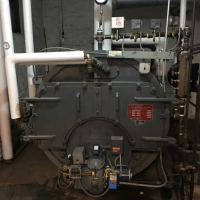Welcome! Here are the website rules, as well as some tips for using this forum.
Need to contact us? Visit https://heatinghelp.com/contact-us/.
Click here to Find a Contractor in your area.
If our community has helped you, please consider making a contribution to support this website. Thanks!
Sandblast radiators and...
Options
Comments
-
It would probably be wise to consult the paint's manufacturer to ask whether harmful chemical vapors will be emitted when their paint is heated to 215 degrees Fahrenheit over and over. Many household paints are not intended for that temperature and most engine paints are assumed to be under the hood, not in living space. I once had the "privilege" of being in a hallway that had a refurbished steam radiator freshly installed. The stink coming off of the hot painted iron was so noxious is felt like my nose, throat, and lungs were on fire. It took hours for the burning sensation to go away and days for the smell to leave my clothing.0
-
In my 1928 home, was the reason the hot water pipes in the basement and the ceiling radiator in the basement garage painted SILVER to reduce the heat loss from the pipes? Both the large 4 inch supply and return lines are painted all through the basement and I think these pipes looks like they were painted in 1928. I recently gave them a second coat of silver to make them look a bit nicer. Was that a good thing to do?1
-
Scott - Should be no problem. Cant imagine tbe paint has a significant impact one way or the other re temperature loss. I’m sure it looks good though!0
-
Sorta glad I hadn’t seen this thread earlier as it may have scared me off from refinishing.
Back in October I finally got sick of looking at layers and layers of old paint flaking off 2 of the larger radiators in my house. Found a local powder coating guy who could blast and coat. He reco’d Prismatic Powders who carry about 9000 color options for the discerning (read “particular”) customer. Only took a couple days to blast, coat, and bake and they came out great. Can actually see a lot more detail than I’d ever noticed before.
Next season I may do the same to the rest of them.



6 -
If you're in Northern NJ, there's an auto body guy (specializes in old cars for movie sets) who has a sideline in radiator sandblasting. Check my post history.https://us.v-cdn.net/5021738/uploads/editor/0e/drs2ypb6xoao.jpg1
Categories
- All Categories
- 87.3K THE MAIN WALL
- 3.2K A-C, Heat Pumps & Refrigeration
- 61 Biomass
- 429 Carbon Monoxide Awareness
- 120 Chimneys & Flues
- 2.1K Domestic Hot Water
- 5.8K Gas Heating
- 114 Geothermal
- 166 Indoor-Air Quality
- 3.7K Oil Heating
- 77 Pipe Deterioration
- 1K Plumbing
- 6.5K Radiant Heating
- 395 Solar
- 15.7K Strictly Steam
- 3.4K Thermostats and Controls
- 56 Water Quality
- 51 Industry Classes
- 50 Job Opportunities
- 18 Recall Announcements





